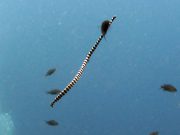Tauchen mit Seeschlangen
Meeresleben von Lanta | Hydrophiinae
Seeschlangen sind eine Familie von 69 Giftschlangen, die in warmen Küstengewässern vom Indischen Ozean bis zum Pazifik vorkommen und eng mit den giftigen australischen Landschlangen verwandt sind.
Zu dieser Familie gehören Arten mit einigen der stärksten Gifte aller Schlangen, und wir können eine bestimmte Art bei Koh Lanta Tauchausflügen sehen.
Alle Seeschlangen haben paddelartige Schwänze und viele haben einen aalartig zusammengedrückten Körper, der ihnen ein aalähnliches Aussehen verleiht. Einige Arten können mit dem Gebänderten Schlangenaal (Myrichthys colubrinus) verwechselt werden, die sich jedoch durch die Form des Kopfes unterscheiden lassen.
Im Gegensatz zu Fischen haben sie keine Kiemen und müssen regelmäßig an die Oberfläche, um zu atmen. Eine einzigartige Anpassung ist jedoch ihre Fähigkeit, Sauerstoff über die Hautoberfläche aufzunehmen. Seeschlangen können bis zu 20 % ihres Sauerstoffbedarfs über die Haut aufnehmen und den größten Teil ihres Kohlendioxids über die Haut ausscheiden.
1 Arten auf dieser Seite gefunden:
Colubrine (Banded) Sea Krait
(Laticauda colubrina)
The yellow-lipped banded sea snake (Laticauda colubrina) is a species of highly venomous sea snake found in tropical Indo-Pacific oceanic waters, and at all of the dive sites around Koh Lanta.
The snake has 20 - 65 distinctive black stripes on a usually blue or blue-grey body and a usually (but not always) yellowish snout. These bands extend from the neck area to the tip of the paddle-like tail which is used for swimming. Adult males can reach 75 cm. Females are significantly larger than males, reaching 128 cm in length.

Female Laticauda colubrina @ Koh Bida
The banded sea snake spends much of its time underwater in order for it to hunt, but returns to land to digest, rest, slough skin, and reproduce. On land, the snakes drink fresh water.
These snakes primarily feed on varieties of eels, but also eat small fish. Adult males normally hunt in shallow water for small moray eels, and adult females normally hunt in deeper water for conger and garden eels They can hold their breath for long periods while they look for prey of eels and small fish, when they find some food they paralyze it through a bite and administer powerful venom. Despite often being much smaller than the eels they feed on, banded sea snakes swallow their prey whole, then return to land to digest their prey.
As with the sea turtles and other reptiles, the banded sea krait is oviparous, meaning it lays eggs that develop outside of the body. And just like the other reptiles, these snakes must come ashore to nest. A lesser known fact about the banded sea snake is that it exhibits 'philopatry' which means, just like with sea turtles, it will return to the same beach time and time again to digest, rest and lay eggs.
Mating occurs in the water whereby the male will 'chase' the female until he becomes entwined with her in order to mate. Females return to their 'home' beach to lay up to 10 eggs in a clutch, which they will deposit in a nest in a crevice or underneath ledges. The incubation period is 4 months, after which, the juvenile sea snakes will hatch and make their way to shallow water.
This species of sea snake is not aggressive, and only attacks when threatened. If they do bite, it is usually in self-defense when accidentally grabbed. Most sea snake bites occur when fishermen attempt to untangle the snakes from their fishing nets. An old wives tail is that their fangs are too small to bite a person but this is not true but with the fangs are only a few cm long it means that they would find it difficult to penetrate a thick wetsuit.
The banded sea snake is hunted by sea birds, sharks, some larger moray eels and some bony fish.
Tauchen mit Seeschlangen rund um Koh Lanta
Tauch- und Schnorchelausflüge
Wenn Sie gerne die Gelegenheit hätten, Seeschlangen auf einem unserer täglichen Tauchausflüge während der Hochsaison von Koh Lanta aus zu sehen, dann senden Sie uns eine E-Mail an info@diveandrelax.com.
Nehmen Sie an unseren Speedboot-Tauchausflügen in der Hochsaison zu einigen der besten Tauchplätze Thailands teil und genießen Sie kleine Gruppen, kurze Fahrzeiten und einen Fokus auf hervorragenden persönlichen Service, Sicherheit und Spaß.
Noch kein zertifizierter Taucher? Lernen Sie auf Koh Lanta das Tauchen mit dem 3-tägigen SSI Open Water Diver Kurs.
Buchen Sie online und sparen Sie 10% auf Tauchausflüge und Tauchkurse auf Koh Lanta.
Weitere Informationen
Indo-Pazifische Meereslebewesen-Führer
- Allen, G., Steene, R., Humann, P., DeLoach, N. (2003) Reef Fish Identification, Tropical Pacific. Jacksonville, FL., USA: New World Publications, Inc., ISBN 1-878348-36-1.
- Humann, P., DeLoach, N., (2010) Reef Creature Identification, Tropical Pacific. Jacksonville, FL., USA: New World Publications Inc., ISBN 978-1-878348-44-9
- Debelius, H. (2013) Indian Ocean Reef Guide. Frankfurt, Germany: IKAN - Unterwasserarchiv, ISBN 978-3-939767-52-7.
- Debelius, H. (2004) Nudibranchs and Sea Snails, Indo-Pacific Field Guide. Frankfurt, Germany: IKAN - Unterwasserarchiv, ISBN 3-925919-51-1
- Erhardt, H., Knop, D. (2015) Corals Indo-Pacific Field Guide. Frankfurt, Germany: IKAN - Unterwasserarchiv, ISBN 3-925919-69-4.
- Veron J.E.N., Stafford-Smith M.G., Turak E. and DeVantier L.M. (2016). Corals of the World
Weitere Referenzen zu Meereslebewesen und weitere Informationen


